
Types of Pallet Wrap
Choosing the right pallet wrap is essential to the success and safety of your warehouse. Using the right type of stretch wrap can keep products organized and stable during storage and transit while choosing the wrong type can result in lost products, damage, and an inefficient wrapping process. Whether you've just started a warehouse or have worked in an industrial setting for years, it's essential to stay educated on the different types of pallet wrap available to you and what sets them apart. We'll investigate the various types of stretch wrap, the most common stretch wrap gauges, and accessories that can improve your wrapping process below.
Shop All Pallet Wrap
Use the following links to skip to the pallet wrap information that most interests you:
Stretch wrap, also called stretch film or pallet wrap, is used to secure goods to a pallet. It serves as a protective barrier, keeping items tightly bound together during transportation or storage. Stretch wrap prevents goods from shifting, sliding, or toppling, reducing the risk of damage during transit. Most stretch wraps are made from linear low-density polyethylene (LLDPE).
Stretch wrap is available in various thicknesses, widths, and lengths to accommodate different packaging needs. Thicker films offer increased strength and puncture resistance, making them suitable for heavier or more fragile items. Meanwhile, narrower films are ideal for smaller packages or when a lighter touch is required.
Blown vs Cast Stretch Wrap
There are two main classifications for stretch wrap material: blown stretch wrap and cast stretch wrap. Each type features distinct characteristics that set them apart, and both are used for a wide range of industrial applications.
- Cast stretch wrap: This type of stretch wrap material is known for its clarity, making it easy to scan barcodes and labels on your products. It is considered less durable than its counterpart and should be used for light- or medium-duty applications. Cast stretch wrap features a two-sided cling and is significantly quieter during use.
- Blown stretch wrap: This stretch wrap material is less clear than its counterpart, but compensates with a high stretch capacity and durability. Because of this, it is ideal for heavy-duty wrapping applications. It provides extra protection during transit and storage and is useful when wrapping items with sharp edges or irregular shapes. It's important to note that blown stretch wrap tends to make more noise during the wrapping process.
With so many different types of pallet wrap available, it can be difficult to identify which one fits your warehouse's needs. Ultimately, the type of pallet wrap you choose depends on the types of products you ship and how large your operation is. We'll introduce the most popular types of pallet wrap below:
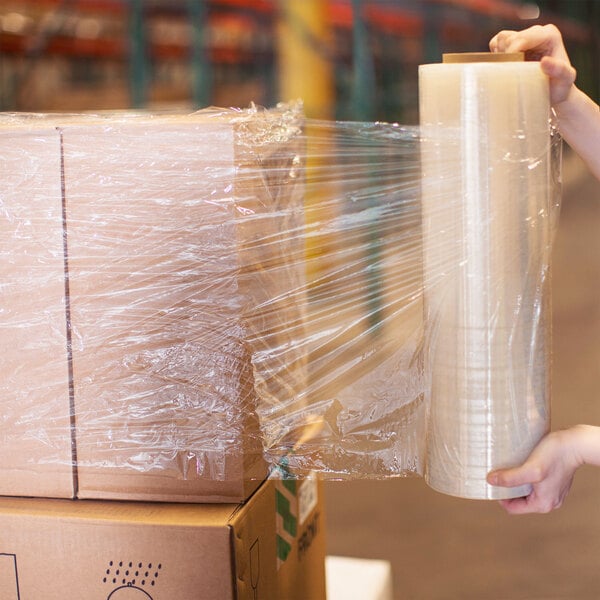
General Purpose Stretch Wrap
One of the most popular types of pallet wrap is general-purpose stretch wrap, which is known for its cost-effectiveness and versatility. General-purpose stretch wrap is meant to withstand the rigors of transportation and handling, ensuring that your products arrive at their destination intact. It can be used to wrap everything from lightweight boxes to heavy machinery, making it a go-to choice for many types of warehouses. This tear- and puncture-resistant film protects your products from dust, moisture, and tampering.
General Purpose Wrap Characteristics
- Clear
- Reliable
- Puncture-resistant
- Easy to dispense
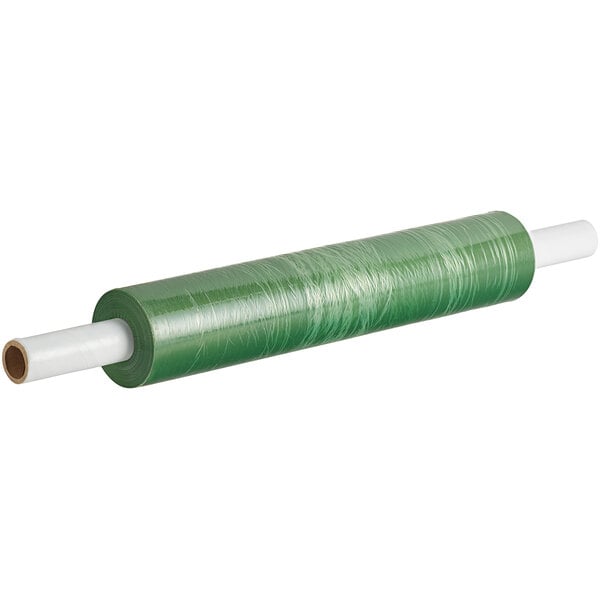
Color Stretch Wrap
Color stretch wrap is a specialty stretch wrap that allows you to color-code your warehouse. By assigning different colors of stretch wrap to pallets, warehouse managers can quickly and easily identify products or shipments. Some warehouses wrap products in different colors based on their production date, allowing them to track which are the oldest. Color stretch wrap is also commonly used in international transportation, as many countries have specific regulations about how to package products for importation and exportation.
Color Stretch Wrap Characteristics
- Easy to identify
- Tamper-proof
- Improved appearance
- Puncture-resistant
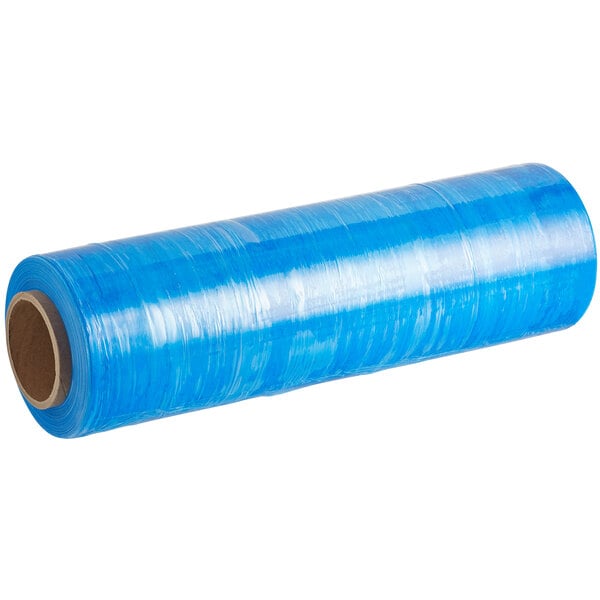
VCI Stretch Wrap
Also known as corrosion-inhibiting stretch wrap, VCI stretch wrap protects metal components during storage and transportation by preventing oxidation. Oxidation is a chemical reaction that occurs when metal components come in contact with oxygen and moisture, resulting in rust, corrosion, and other forms of damage. By using VCI stretch wrap, you can create a barrier that blocks moisture and oxygen, effectively preventing oxidation from occurring. This type of wrap is typically used for machinery, metal components, and tools.
VCI Stretch Wrap Characteristics
- Corrosion-inhibiting
- Provides long-lasting protection
- Can be used indoors and outdoors
- Advanced durability

UVI Stretch Wrap
UVI stretch wrap is a specialty wrap that includes light-discouraging additives to protect pallets from ultraviolet radiation. Ultraviolet rays can cause yellowing or discoloration of products or packaging over time, making UVI stretch wrap an excellent product for businesses that need to maintain the quality and appearance of their products. With this wrap, businesses can prevent unnecessary damage and ensure that their products arrive at their destination in pristine condition.
UVI Stretch Wrap Characteristics
- Treated with ultraviolet additives
- Slow degradation rate
- Ideal for outdoor use
- Can be clear or opaque
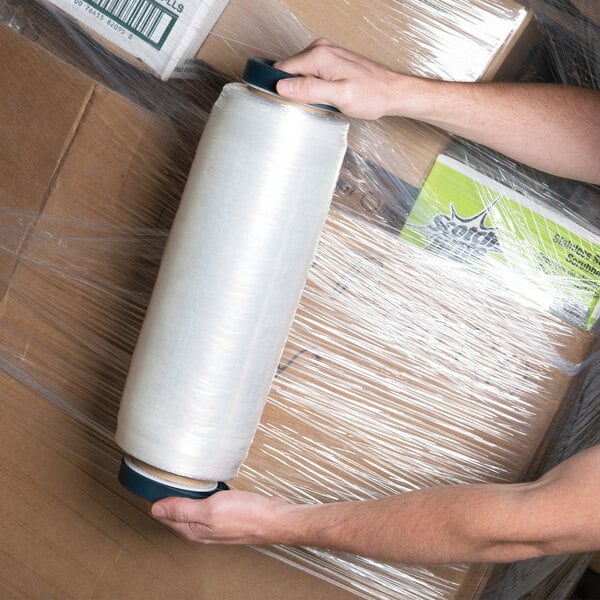
Pre-Stretch Wrap
Pre-stretched wrap is mechanically stretched close to its breaking point before being wound onto rolls. This process results in a lightweight wrap that offers consistent tension and good load stability. Because it does not require as much energy as other films to achieve the same wrapping force, this wrap reduces the strain on your employees during the wrapping process. Additionally, pre-stretch wrap uses nearly half as less film as other pallet wraps, making it a cost-effective solution for businesses looking to reduce their packaging expenses.
Pre-Stretch Wrap Characteristics
- Lightweight and durable
- Improved cost savings
- Increased holding force
- Less environmental waste
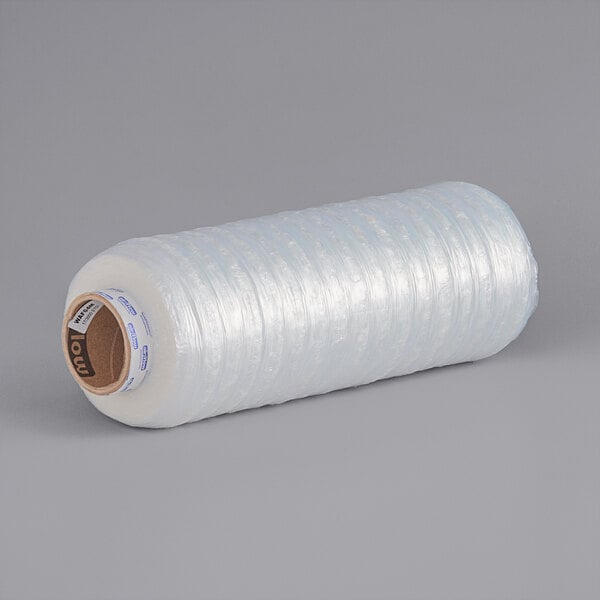
Vented Stretch Wrap
Vented stretch wrap, also known as breathable stretch wrap or pallet netting, is a type of pallet wrap with a vented design. This facilitates proper air circulation, making it ideal for wrapping wood, landscaping products, hot and cold foods, and produce. By allowing air to circulate around the pallet, vented stretch wrap helps to prevent moisture buildup and mold growth, ensuring that the product arrives at its destination in the best possible condition.
Vented Stretch Wrap Characteristics
- Vented design
- Slows foods from rotting
- Prevents
- Reinforced fiber
Gauge represents how thick a stretch wrap is. Stretch wraps can range from as low as 23 gauge to as high as 150 gauge. The higher the gauge, the more durable your stretch wrap will be. It's important to note that in most cases, the price of stretch wrap increases as the gauge increases. We've outlined some of the most common stretch wrap gauges below:
- 37 gauge: This light-duty gauge is typically found in pre-stretched wraps.
- 47 gauge: A hybrid gauge that can be used for heavier products, but should not be used for products with sharp edges or abnormal shapes.
- 60 gauge: This medium-duty gauge features increased puncture resistance and can be used for heavier objects.
- 70 gauge: This is a medium-duty gauge that features increased durability and can be used to wrap heavy pallets or products with mildly sharp edges.
- 80 gauge: This is the most common gauge for stretch wraps. It is known for its versatility and has a wide range of wrapping applications.
- 90 gauge: This hybrid gauge featured enhanced durability and can be used to wrap some heavy-duty loads.
- 100 gauge: This heavy-duty gauge is ideal for wrapping heavy pallets.
- 115 gauge: This is a heavy-duty gauge that features superior durability and tear resistance.
- 150 gauge: This gauge offers the most strength and puncture resistance. It can be used to wrap heavy-duty pallets and objects with irregular shapes or sharp edges.
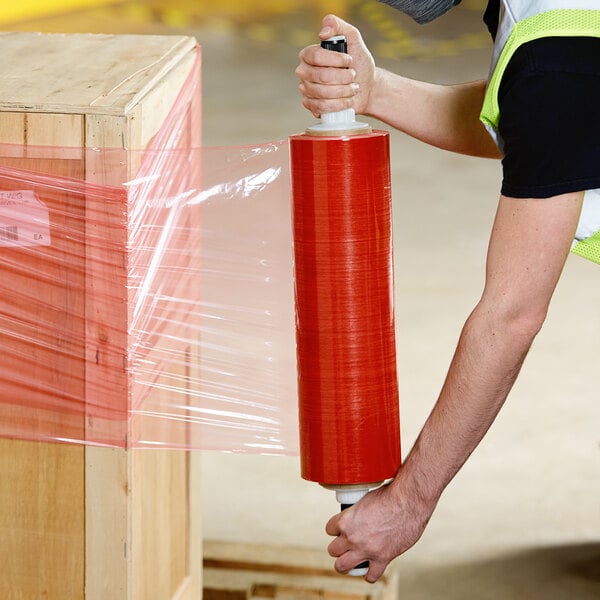
When it comes to pallet wrapping, having the right tools, machines, and accessories can make a big difference in the efficiency of your staff. When used correctly, these accessories can help you optimize the wrapping process. Some common pallet wrapping tools and accessories include the following:
- Stretch wrap machines: A stretch wrap machine allows you to automate the pallet wrapping process, saving time and effort. They can be adjusted for size and scale, making them a great option for businesses of all sizes.
- Stretch wrap dispensers: A stretch wrap dispenser make wrapping pallets by hand more efficient. They come in several forms and can be used for light-, standard-, and heavy-duty wrapping applications.
- Film cutters: When it comes to cutting stretch wrap film, using a pair of scissors can be frustrating and time-consuming. A film cutter offers a safer and more efficient way to slice through the film for precise cuts.
There are three different types of stretch wrap cores: standard, one-sided extended, and two-sided extended. Continue reading to learn about both types and what sets them apart:
- Standard cores: These cores are ideal for use with machines or dispensers. They fit perfectly onto the spindle of a stretch wrap machine and are compatible with most stretch wrap dispensers.
- One-sided extended cores: These cores allow for quick and efficient use without the added expense of a dispenser. One-sided extended cores have an extended length on only one side, which makes it easier to apply the wrap by hand.
- Two-sided extended cores: Two-sided extended cores have an extended length on both sides, which makes them ideal for businesses that need to wrap pallets quickly and efficiently.
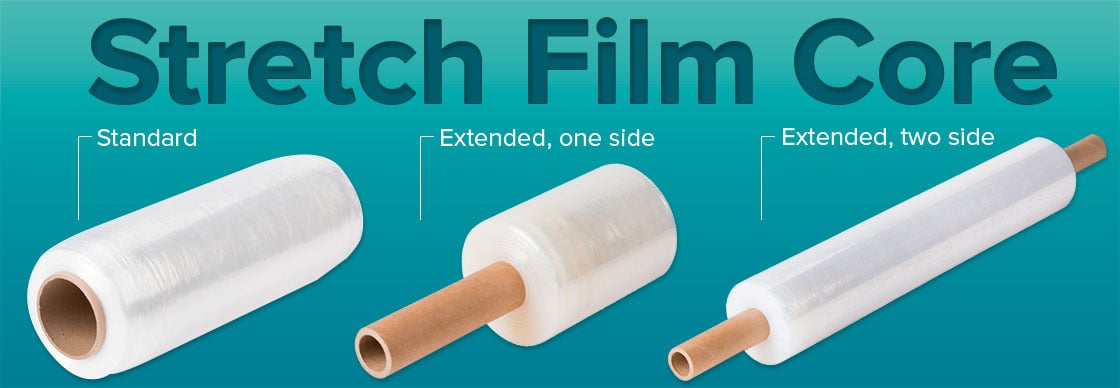
Educating yourself on the key terms associated with pallet wrap and pallet wrapping can help you make informed purchasing decisions and contribute to a successful warehouse environment. We've defined common pallet wrapping terms below:
- Banding: The act of applying multiple wraps of stretch film to a certain area of a load to reinforce it or to band together multiple units.
- Bottom wraps: The revolutions of film applied to the lower layers of a pallet or load. Typically more than one revolution is applied to this area to increase the load stability of the unitized load.
- Top wraps: The extra revolutions of stretch film applied to the top portion of the load to be wrapped.
- Core: The reinforced, hollow cardboard cylinder around which the stretch film is rolled.
- Gauge: The thickness of a plastic sheet, or in this case, stretch film, measured in mils or microns.
- LLDPE: LLDPE stands for linear low-density polyethylene. It is the most common stretch wrap material.
Related Resources
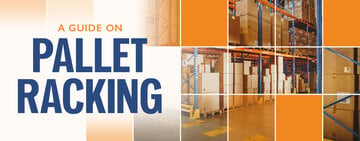
Pallet Racking
If you operate a warehouse , you'll know that implementing a strong organization method is imperative for running a successful business. A pallet racking system is a great way to help with just that by organizing stock, carrying out orders succesfully, and maximizing space in your warehouse setup . Shop All Pallet Racks Use the following links to learn more about pallet racking: Types of Pallet Racking Installing Pallet Racking Pallet Racking FAQs What Is Pallet Racking? Pallet racking is a storage system method that organizes palletized materials. The racks are set up horizontally and on multiple levels to utilize vertical space in buildings such as warehouses. Additionally, they are organized in such a way that forklifts and other materia
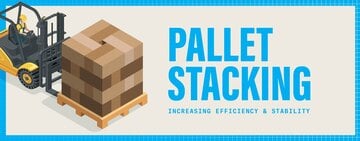
Pallet Stacking
Properly shipping goods to your customers comes with a lot of variables to keep in mind, like which corrugated box is best for orders, or how to ship your small business's goods at the best price. And when you're working in a distributing center, knowing how to stack a pallet to make sure the contents aren't damaged is the top shipping priority. Pallet stacking is more than getting the boxes perfectly packed. It's what keeps your employees safe from boxes toppling over, as well as optimizing freight costs so you make money from your endeavors. Below we have outlined how to stack a pallet, the best pallet stacking patterns, and how to stack mixed boxes on a pallet. Shop All Pallets How to Stack Boxes on a Pallet Listed below is the best way

Order Picking in a Warehouse
Order picking is the first step in the fulfillment process for an ecommerce business or distribution center. When an order is placed with your company, the items must be "picked" from your storage area. The type of order picking that you implement heavily influences the organization and layout of your warehouse . Picking is also one of the most expensive processes in warehouse operations, which means it should be planned out with care. Keep reading to learn about order picking and how to incorporate different picking strategies. Shop Order Picking Carts What Is Order Picking? Order picking is the process of pulling items from storage areas to fulfill customer orders. This is a manual process that requires order pickers to physically locate
- Topics 1344
- Industrial 55
- Troubleshooting Guides 21
- Restaurant Management 128
- Bar Management 55
- Catering Tips 35
- Bakery Management 41
- Food Trucks & Concessions 49
- Advertising & Marketing 37
- Eco-Friendly Tips 11
- Facility Layout & Design 41
- Coffee Shop Tips 27
- Installation & Maintenance 51
- Janitorial & Pest Control 30
- Safety & Sanitation 88
- Startup Tips 104
- Menu Design 10
- Kitchen & Cooking Tips 81
- Hospitality Management 23
- Pizza & Sandwich Shop Tips 36
- Smallwares 37
- Food Prep 88
- Tabletop Items 17
- Disposables 22
- Calculators & Tools 6
- Consumables 52
- Warewashing & Laundry 18
- Cooking Equipment 90
- Food Storage & Refrigeration 51
- Beverage Equipment 34
- Office Supplies 6
- Resource Type
- In-Depth Articles272
- Buying Guides296
- How-Tos93
- Product Reviews77


